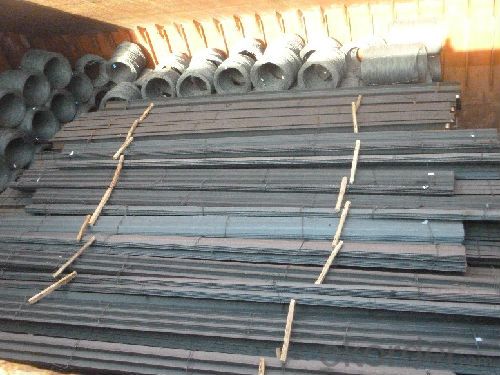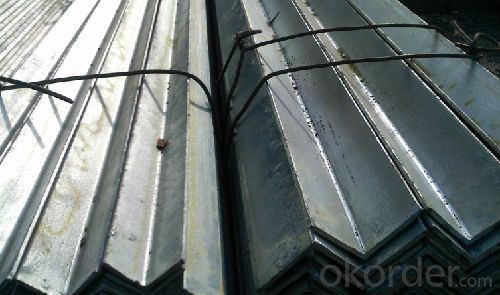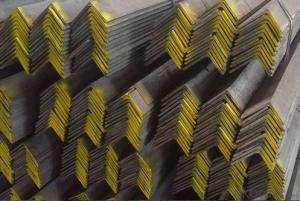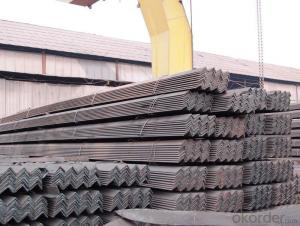Unequal Angles Hot Rolled, Standard Unequal Angle Steel
- Loading Port:
- Tianjin
- Payment Terms:
- TT or LC
- Min Order Qty:
- 30 m.t.
- Supply Capability:
- 40000 m.t./month
OKorder Service Pledge
OKorder Financial Service
You Might Also Like
Product Description:
OKorder is offering Unequal Angles Hot Rolled, Standard Unequal Angle Steel at great prices with worldwide shipping. Our supplier is a world-class manufacturer of steel, with our products utilized the world over. OKorder annually supplies products to European, North American and Asian markets. We provide quotations within 24 hours of receiving an inquiry and guarantee competitive prices.
Product Applications:
Unequal Angles Hot Rolled, Standard Unequal Angle Steel are ideal for structural applications and are widely used in the construction of buildings and bridges, and the manufacturing, petrochemical, and transportation industries.
Product Advantages:
OKorder's Unequal Angles Hot Rolled, Standard Unequal Angle Steel are durable, strong, and resist corrosion.
Main Product Features:
· Premium quality
· Prompt delivery & seaworthy packing (30 days after receiving deposit)
· Corrosion resistance
· Can be recycled and reused
· Mill test certification
· Professional Service
· Competitive pricing
Product Specifications:
Hot Rolled Steel Unequal Angles
1. Shape:Unequal
2. Standard:ASTM,BS,DIN,GB,JIS
3.Grade:Q195,Q235,Q345,SS400,A36,ST37
May we help you to optimize your products sourcing? | |
1. Strategic location: Our factory is located in the famous steel town of Shengfang. | |
2. Industrial product expertise | |
3. Product reliability, competitive price, and on-time delivery | |
4. Unparalleled service and reliability | |
5. Business philosophy: Credit First, Be Honesty, Mutual Benefit and Customer Supremacy. | |
Detail information: | |
Type | Equal & Unequal |
Thickness Tolerance | +/- 8% |
Packing | export standard packing(bundles, seaworthy package, shipped in container) |
Delivery Port | Tianjin, China |
Lead Time | within 30days after received the original L/C or deposit |
MOQ | 10 Tons per size |
Certificate | SGS Certificate if needed; the cost of inspection for buyer. |
Usage | Construction, communications steel tower, civil or agricultural machine making |
Production Capacity | 5,000MT per month |
Main Market | Europe, America, Africa, Southeast |
Welcome every old and new clients to come to negotiate and telecommunicate with us | |
FAQ:
Q1: Why buy Materials & Equipment from OKorder.com?
A1: All products offered byOKorder.com are carefully selected from China's most reliable manufacturing enterprises. Through its ISO certifications, OKorder.com adheres to the highest standards and a commitment to supply chain safety and customer satisfaction.
Q2: How do we guarantee the quality of our products?
A2: We have established an advanced quality management system which conducts strict quality tests at every step, from raw materials to the final product. At the same time, we provide extensive follow-up service assurances as required.
Q3: How soon can we receive the product after purchase?
A3: Within three days of placing an order, we will begin production. The specific shipping date is dependent upon international and government factors, but is typically 7 to 10 workdays.
Q4: What makes stainless steel stainless?
A4: Stainless steel must contain at least 10.5 % chromium. It is this element that reacts with the oxygen in the air to form a complex chrome-oxide surface layer that is invisible but strong enough to prevent further oxygen from "staining" (rusting) the surface. Higher levels of chromium and the addition of other alloying elements such as nickel and molybdenum enhance this surface layer and improve the corrosion resistance of the stainless material.
Q5: Can stainless steel rust?
A5: Stainless does not "rust" as you think of regular steel rusting with a red oxide on the surface that flakes off. If you see red rust it is probably due to some iron particles that have contaminated the surface of the stainless steel and it is these iron particles that are rusting. Look at the source of the rusting and see if you can remove it from the surface.
Images:



- Q:What is the maximum temperature steel angles can withstand?
- The maximum temperature that steel angles can withstand depends on the specific grade of steel being used. Generally, carbon steel can withstand temperatures up to around 1000°C (1832°F) before it starts to lose its structural integrity. However, other factors such as the duration of exposure to high temperatures, the load applied, and the cooling rate after exposure also play a role in determining the maximum temperature that steel angles can withstand. It is always recommended to consult the manufacturer's specifications or a structural engineer to ensure that the steel angles are used within their safe temperature limits.
- Q:What are steel angles?
- Steel angles are a type of steel structural shape that is commonly used in construction and engineering projects. They are L-shaped beams with two legs of equal or unequal length, forming a 90-degree angle. Steel angles are typically made from hot-rolled steel and can be found in various sizes and thicknesses. These angles are versatile and have a wide range of applications. They are commonly used as framing elements in buildings and bridges, providing support and stability. Steel angles can also be used as reinforcement in concrete structures or as brackets and supports for various equipment and machinery. One of the key advantages of steel angles is their strength and durability. They are designed to withstand heavy loads and provide structural integrity. Additionally, steel angles are resistant to corrosion, making them suitable for outdoor applications and environments with high moisture or chemical exposure. Steel angles are available in different grades, with each grade having specific mechanical properties and characteristics. This allows engineers and designers to choose the appropriate angle based on the requirements of the project. In conclusion, steel angles are essential components in construction and engineering. They provide strength, stability, and versatility in various applications. Whether it is for structural support or reinforcement, steel angles play a crucial role in ensuring the integrity and safety of a wide range of structures.
- Q:What are the different methods of surface protection for steel angles?
- There are several methods available for surface protection of steel angles, including painting, galvanizing, powder coating, and applying protective coatings such as epoxy or polyurethane. Each method offers varying degrees of protection against corrosion and damage, depending on the specific requirements and environment in which the steel angles will be used.
- Q:Can steel angles be used for structural applications?
- Yes, steel angles can be used for structural applications. Steel angles are commonly used in construction and engineering projects due to their strength, durability, and versatility. They are particularly useful in providing structural support and stability, as they can be easily welded, bolted, or otherwise connected to other steel components. Steel angles are often utilized in the construction of frames, supports, braces, and reinforcements. Additionally, their shape and design allow for efficient load-bearing capabilities, making them suitable for various structural applications such as bridges, buildings, towers, and industrial structures. Overall, steel angles are a reliable and cost-effective choice for structural applications.
- Q:How do steel angles compare to wooden or concrete structural elements?
- Steel angles have several advantages over wooden or concrete structural elements. Firstly, steel angles have a higher strength-to-weight ratio, making them capable of supporting heavier loads with less material. This allows for more efficient structural designs and reduces the overall weight of the structure. Additionally, steel angles have better resistance to fire, pests, and moisture, eliminating concerns related to rotting, termite damage, or decay. Moreover, steel angles provide greater flexibility in terms of design and can be easily modified or extended if needed. Lastly, steel angles offer increased durability and longevity, requiring less maintenance and having a longer lifespan compared to wooden or concrete elements.
- Q:What are the different design considerations for steel angles in architectural applications?
- When incorporating steel angles into architectural applications, there are various factors to consider. These factors encompass load-bearing capacity, structural integrity, aesthetics, design flexibility, and corrosion resistance. Load-bearing capacity is a primary concern when using steel angles in architectural applications. They are often employed for structural support purposes, so it is essential to ensure they can withstand the anticipated loads. This necessitates calculating the maximum load they will bear and selecting angles of appropriate size and thickness to handle these loads safely. Structural integrity is another crucial consideration. Architects and engineers must take into account factors such as the angles' resistance to bending, buckling, and shear. The design must also consider their ability to distribute loads evenly, minimizing the risk of failure or deformation. Aesthetics also hold significant importance in architectural design, and steel angles can contribute to the overall visual appeal of a building. By incorporating angles with different profiles, finishes, or decorative elements, architects can enhance the design and create visually appealing structures. It is crucial for the angles to complement the overall architectural style and seamlessly blend with other building materials. Design flexibility is another vital consideration. Architects often require angles that can be easily customized or fabricated to meet their specific design requirements. Steel angles offer the ability to be cut, welded, or bent, allowing for the creation of unique shapes and angles and enabling creative architectural solutions. Lastly, it is important to evaluate the material properties and corrosion resistance of the steel angles. Architects need to assess the environmental conditions of the project site and choose angles that can withstand exposure to moisture, chemicals, or other corrosive agents. Applying proper coatings or treatments can protect the angles from corrosion and ensure their longevity. In conclusion, the design considerations for steel angles in architectural applications include load-bearing capacity, structural integrity, aesthetics, design flexibility, and corrosion resistance. By carefully examining these factors, architects can select steel angles that fulfill both the functional and visual requirements of their projects, resulting in safe, durable, and visually appealing architectural structures.
- Q:Can steel angles be used for support structures in sports facilities?
- Yes, steel angles can be used for support structures in sports facilities. Steel angles are commonly used in construction due to their high strength and durability. They provide excellent support and stability, making them suitable for various applications in sports facilities such as supporting beams, columns, and trusses. Steel angles can effectively handle heavy loads and withstand the dynamic forces that occur in sports facilities, making them a reliable choice for supporting structures. Additionally, steel angles can be easily fabricated, allowing for customization to meet specific design requirements. Overall, steel angles are a versatile and widely used material for support structures in sports facilities.
- Q:How do steel angles contribute to the overall strength of a structure?
- Steel angles contribute to the overall strength of a structure in several ways. First and foremost, they provide structural stability by distributing the load and forces evenly throughout the structure. The L-shape of steel angles allows them to resist bending and twisting, making them ideal for providing support and preventing deformation. Steel angles are often used as bracing elements in construction due to their high strength-to-weight ratio. By adding diagonal steel angles to a structure, it becomes more resistant to lateral forces such as wind or seismic loads. These angles help to transfer the applied forces to the foundation, reducing the risk of structural failure. Another way steel angles contribute to strength is by providing additional reinforcement. They can be strategically placed at critical points of a structure, such as corners or joints, to enhance its overall rigidity and durability. Steel angles can also be used as framing members, supporting beams, or columns, further enhancing the load-bearing capacity of the structure. Moreover, steel angles are resistant to corrosion and have a long lifespan, making them a reliable choice for structural applications. They can withstand harsh environmental conditions, ensuring the structural integrity of the building over time. Overall, steel angles play a crucial role in enhancing the strength and stability of a structure. Their ability to distribute loads, resist bending and twisting, provide reinforcement, and withstand environmental factors make them an essential component in modern construction.
- Q:How do you design connections for steel angles to concrete?
- To design connections for steel angles to concrete, several factors need to be considered. Firstly, the load requirements and type of connection (such as shear, tension, or moment) must be determined. Then, appropriate connection methods like embedded plates, anchor bolts, or post-installed anchors can be selected. The design must also consider the concrete strength, angle size, spacing, and edge distances. Detailed calculations are performed to ensure the connection is safe and meets the applicable design codes and standards. Additionally, factors like corrosion protection and construction feasibility should be considered during the design process.
- Q:6# specification for angle iron
- Angle: the angle called angle, the steel strip is perpendicular to each other on both sides into the corner. The angle iron has equal angles and unequal angles. The two sides of an equal angle steel are equal in width. The specifications are expressed in millimeters of edge width * edge width * edge thickness. Such as "/ 30 x 30 x 3", that is 30 mm width equal angle, edge thickness of 3 mm. Also available models that model is the number of centimeters wide, such as angle 3#. The model does not mean the size of the different edges and sizes of the same model. Therefore, the width, the edge and the thickness of the angle iron should be filled out in the contract and other documents, so as not to be indicated by the model alone. Standard Specification for hot-rolled equal angle iron is 2#-20#.
1. Manufacturer Overview |
|
|---|---|
| Location | |
| Year Established | |
| Annual Output Value | |
| Main Markets | |
| Company Certifications | |
2. Manufacturer Certificates |
|
|---|---|
| a) Certification Name | |
| Range | |
| Reference | |
| Validity Period | |
3. Manufacturer Capability |
|
|---|---|
| a)Trade Capacity | |
| Nearest Port | |
| Export Percentage | |
| No.of Employees in Trade Department | |
| Language Spoken: | |
| b)Factory Information | |
| Factory Size: | |
| No. of Production Lines | |
| Contract Manufacturing | |
| Product Price Range | |
Send your message to us
Unequal Angles Hot Rolled, Standard Unequal Angle Steel
- Loading Port:
- Tianjin
- Payment Terms:
- TT or LC
- Min Order Qty:
- 30 m.t.
- Supply Capability:
- 40000 m.t./month
OKorder Service Pledge
OKorder Financial Service
Similar products
New products
Hot products
Related keywords



























